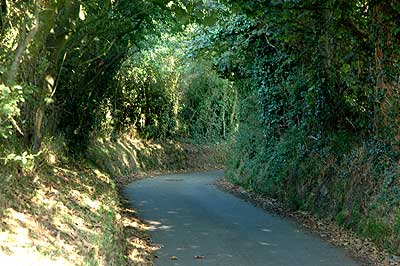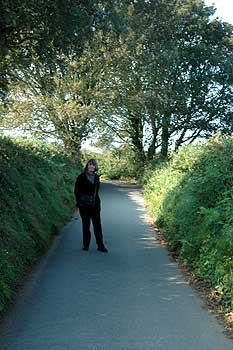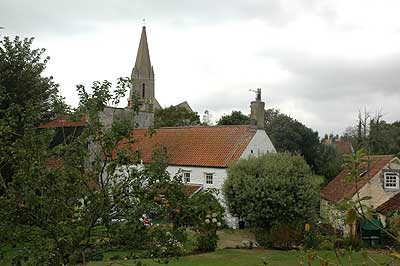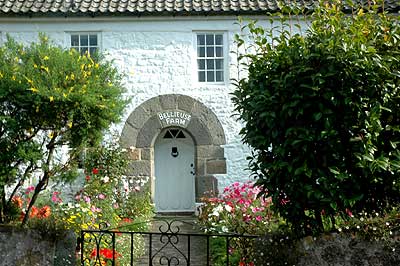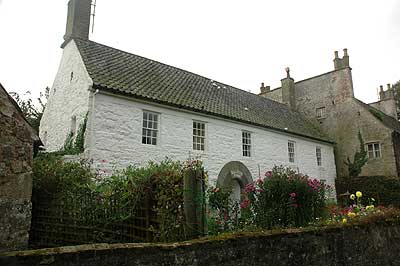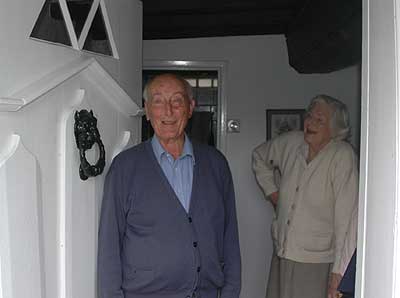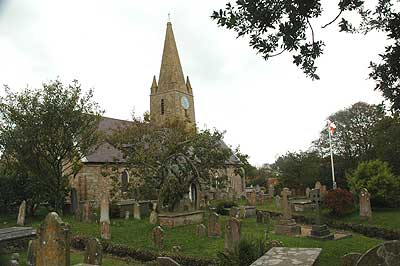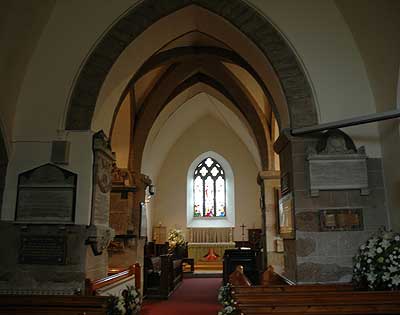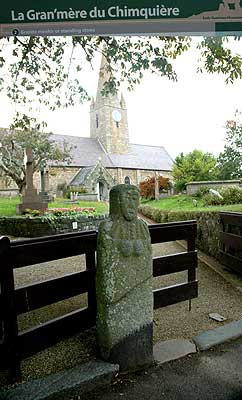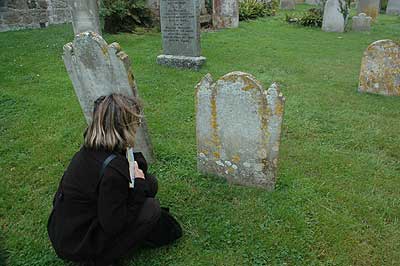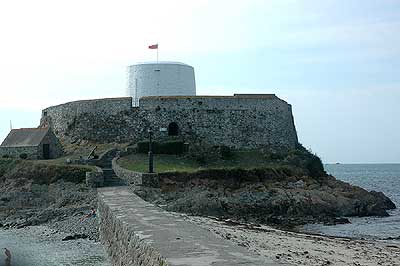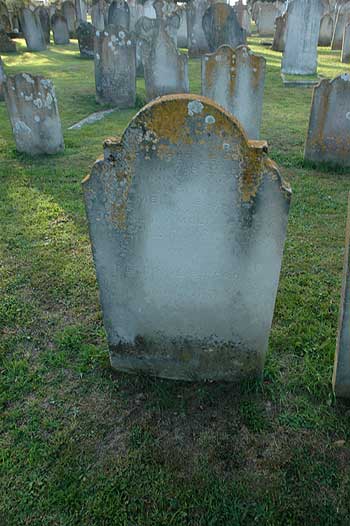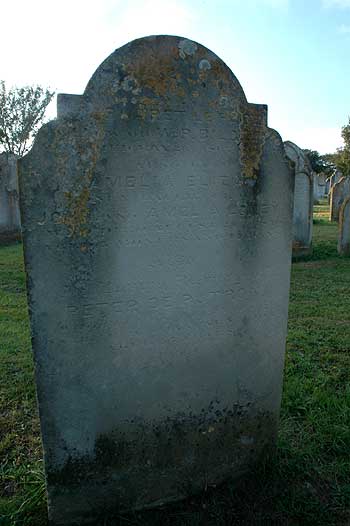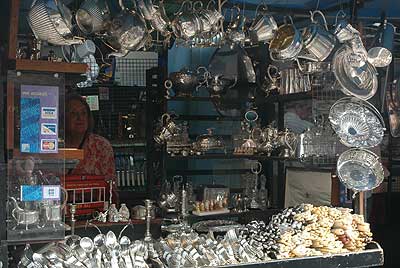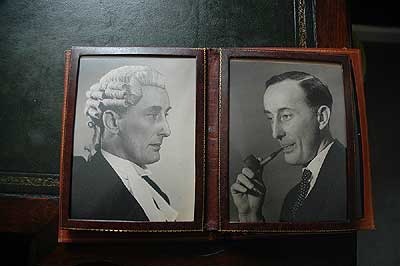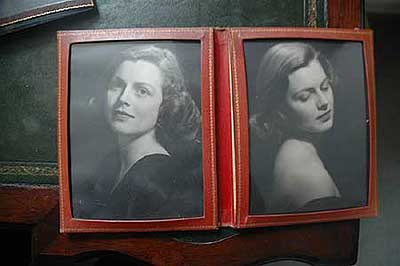Guernsey / London
September 2009
Where is Guernsey, you ask:
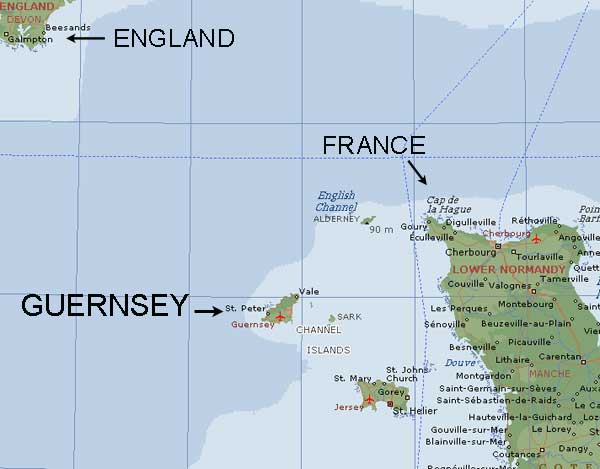
On Sunday 13 Sept 2009 we drove to Toronto (using airport parking) (1) and flew at 17:50 on Thomas Cook to Gatwick airport arriving before 6am (local time) and transferred to Aurigny Airlines that got us into the airport at St. Peter Port, Guernsey (2) at breakfast time on Monday 14 September.
 The taxi trip to the St George’s Hotel, where we had booked 4 nights, took longer than expected and we were a bit disheartened to realize that St. Peter Port was more like a large town than the village we had somehow (erroneously) expected. (An advertisement inside the taxi promoting an investment firm specializing in “wealth management” was just the first sign of the focus here on international banking - and ensuing prosperity). Our hotel was on the waterfront and only a ten minute walk from the centre of town, (3) so we dropped off our bags and took a walk through town to get oriented, have a light lunch (and our first pint of bitters) at local pub and get info from the Tourist Office.
The taxi trip to the St George’s Hotel, where we had booked 4 nights, took longer than expected and we were a bit disheartened to realize that St. Peter Port was more like a large town than the village we had somehow (erroneously) expected. (An advertisement inside the taxi promoting an investment firm specializing in “wealth management” was just the first sign of the focus here on international banking - and ensuing prosperity). Our hotel was on the waterfront and only a ten minute walk from the centre of town, (3) so we dropped off our bags and took a walk through town to get oriented, have a light lunch (and our first pint of bitters) at local pub and get info from the Tourist Office.
Since we had chosen to visit St. Peter Port largely because George’s grandfather was born (in 1880) in this area, we were in search of family history which meant that we headed first for the Greffe, the official archive for the state and the Royal Court. It was closed for lunch so we walked on to the Priaulx Library, (4) Guernsey’s first free public library that opened in 1889 in a converted Georgian townhouse and now houses a wide range of books, maps, prints and photographs relating to the history and the families of the Channel Islands. It was open and we went inside; in contrast to the rather plain exterior, the inside was magnificent with its beautiful old paneling, paintings and, of course, books. The staff was helpful and we booked an appointment to do a search for family records the next day.
By this time, we had been awake almost 24 hours and were forced to admit that we were weary. We headed back to our hotel and settled in to our room (#4) to take a short nap from which we arose, just a couple of hours later, feeling better and ready to head into town for supper – again at a pub and, again, an excellent one.
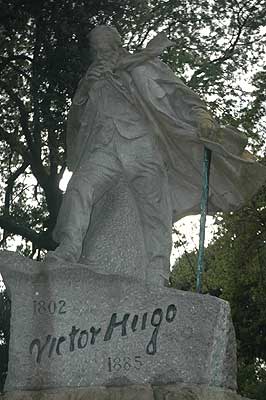 Tuesday started out with a full British breakfast. Sunny and windy; our walk up to the Priaulx Library through winding old streets was delightful. Signs of prosperity were evident in the beautifully kept homes, frequently featuring new, not inexpensive convertibles in their driveways. We spent the morning searching birth, marriage and death records and had some success with the help of very pleasant and knowledgeable staff. By the time we left, it had clouded over and was threatening to rain.
Tuesday started out with a full British breakfast. Sunny and windy; our walk up to the Priaulx Library through winding old streets was delightful. Signs of prosperity were evident in the beautifully kept homes, frequently featuring new, not inexpensive convertibles in their driveways. We spent the morning searching birth, marriage and death records and had some success with the help of very pleasant and knowledgeable staff. By the time we left, it had clouded over and was threatening to rain.
We headed across the road and walked through the gates of an old cemetery in search of the grave of Margaret LePage, the widow of one of the ancestors (William Peter Bartholomew Loney) of whom there was no birth, death or burial records. It started to rain heavily so, we quickly left the cemetery and walked back across the road to the Guernsey Museum and Art Gallery which houses a permanent exhibit telling the story of the Channel Islands from the Neolithic times. It was also featuring an exhibition of Holbein’s portraits of royalty, including such famous characters as Henry VIII, Anne Boleyn and Thomas More.
After walking down the hill and back into town, we had lunch at a restaurant (La Nautique) that had a lovely view over the harbour, excellent service - and fabulous food! Tana had a mushroom risotto that had a large thin round slice of crisp fried parmesan cheese on top and George had calves liver that was served with a black pudding (that he is now trying to replicate). The weather was improving (but still drizzling a bit) when we left so, we walked up to the house in which Victor Hugo had lived during his 15 years of exile (from 1856 to 1870). (He was first forced to leave Paris because of a piece he had written and shortly after from Jersey where he had first tried to settle. When he bought his house in Guernsey, he was assured that he could never be exiled again as a property owner in Guernsey can never be forced to leave the island state). His home, Hauteville House (5) (below), was bequeathed to the City of Paris (from which he had been exiled) after his death. We arrived at the door just in time for a guided tour and discovered that, while unremarkable from the outside, the house on the inside was literally theatrical. Each room was, in some way, breathtaking. Some were covered (walls and ceilings) in tapestries; there were Hugo quotes on the walls – some revealing his feelings about being exiled and others touching on overall themes of darkness and light, freedom, life, death and rebirth. Some rooms had chairs on the ceilings (instead of the floors) and one featured plates and even the lid of a soup tureen on the ceiling).
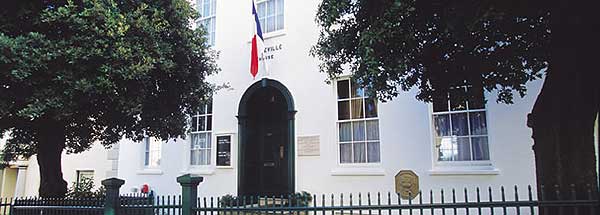
At the very top of the house was the floor on which Hugo slept and wrote – flooded with light and providing a view that swept across the Channel all the way to the shores of France. Some say that the house itself was intended to be read for the meaning it holds much in the same way that any of Hugo’s novels might be read and that the plain exterior is simply a reminder not to judge a book by its cover.
We had planned to have supper at a French restaurant we had seen earlier but it was fully booked so we walked back towards the hotel and had supper at the nearby La Piette Hotel/restaurant. Busy (and lively) when we entered, it quickly cleared out, leaving us seated at the only occupied table. Our loneliness was abated by the conversation of the waiter/bartender who was about (at any moment) to become a father and by a Guernseyman who had traveled to Canada and was profiting from an investment in property in Saskatchewan.
Wednesday was, not unlike every other day, windy but there were moments when the sun broke through; so, we took Bus #7 to St. Martin’s to search for the old family home – La Bellieuse Farm where George’s great-grandparents had lived and where his grandfather had been born. Holding a photo of the farm (with the steeple of a church visible over the roof) we walked a lovely laneway (Ruette Tranquille) that we expected would lead us to the farm house. (6)
|
|
|
|
Guernsey cattle watched us with some mild curiosity and, rounding a corner, we glimpsed what looked to be the church steeple and a farm house came into view. We walked down to the front of the house, noticed the sign over the door “Bellieuse Farm” and, with a mixture of hesitancy and excitement, knocked on the door to ask the owners if we could take photographs of the exterior of their house. They were hospitable, invited us in for coffee and shared with us some of their own history and what they knew (or had heard) about the house; it had been built in the 1400s and inhabited by the monks while the nearby church was being built. Tony Gillett, now retired, was British and had been a Barrister in the Colonial service in British Somaliland/Ethiopia and Aden where he was deputy Attorney General before being assigned to Guernsey as its Magistrate for 14 years.(7) He and Judy, his wife, have been in the house since 1971. (8)
|
|
|
|
|
|
The Gilletts showed us all through the house and allowed us to wander out in their back yard to get some photos from the vantage point of the old 1878 photo which had led us to their door (see the top row of the photos above – the 1878 and the 2009 photos are side by side and show how little things have changed.) After photographing the farm, and getting this parting photo of the Gilletts at their front door, we wandered up to the church and looked unsuccessfully through the cemetery for a Loney grave site. After a good lunch in the local pub, we visited the rector for information about grave sites. He was a pleasant young fellow who quickly forgave us for interrupting his lunch and chuckled as he pulled out a map to show us where to look for the plot; he explained that we might have some difficulty recognizing it as the wording on many of these old stones had eroded, beyond legibility, over the years.
|
|
|
Grave of William Joseph Loney - St. Martins |
The St. Martin’s Parish Church and the cemetery, outside of which stands an ancient pagan goddess statue, takes one back in time. It looks just as it must have looked in the 1800s except that the grave stones are weathered, with some falling over, and the trees are larger, some of them with branches that are completely covering grave stones. We did find the Loney grave stone though, as the rector had warned us, it was impossible to read.
We then walked back through the village and toured Sausmarez Manor which has been the home of the de Sausmarez family for nearly a millennium; it remains the home of the current Seigneur de Sausmarez who, given that the Manor is said to be one of the most haunted houses in Britain, gives ghost tours on Thursday evenings. After touring the Manor, wandering the grounds, and interacting with the many chickens and ducks wandering about, we walked across the road and picked up the #7 bus that loops the island and rode to Fort Grey Shipwreck Museum which, as pictured below, is known locally as ‘the cup and saucer.’ It overlooks one of Guernsey’s magical west coast bays. The Martello Tower was erected in 1804 to defend Guernsey against the French and was manned during both world wars. In 1976 it was converted into a shipwreck museum.
|
|
From there we rode to Cobo Bay where we had been told there was a lovely restaurant; however, it was beginning to rain; so, we walked the coast only briefly before catching the #7 back to St. Peters Port.
Dinner was booked at La Petite Bistro a very popular French restaurant on the High. It was very disappointing – from the abrupt/rude service, to the bad wine (which they reluctantly took back,) to the gritty Bouillabaisse, to the noisy (not just lively) ambience. After leaving we immediately went to La Nautique restaurant on the Esplanade to book dinner for Thursday evening.
Thursday was, of course, windy but, unlike the previous days, remained mostly sunny.
In the morning we returned to the Greffe and were told that the records we wanted access to were available to the public only in the afternoon. With time to spare, we visited Castle Cornet, Guernsey 's ancient harbour fortress, which was isolated upon a rocky islet, until the construction of a breakwater and bridge in the 19th century. The guided tour at 10am gave us a sense of the formidable challenge to any force attempting to invade and the three excellent museums housed within it gave a real sense of the history of Guernsey. Some of the recent history featured the Nazi occupation during World War II. (There are several museums focused on the era of the Nazi occupation which we would have liked to have visited. We did look through several of the books in the local book shop and got just a glimpse of the complexity of life on the Island at that time both for the local citizens and the occupying forces).
Castle Cornet |
|
After lunch, George returned to the Greffe and Steve, a very pleasant fellow, offered to do a search of the records of the Bellieuse Farm to see whether any of the Loney family had been previous owners. He said that he would e-mail or phone us with what information he found for a fee of 5£. True to his word, an email arrived a week later listing the owners for the past few centuries – but there was no request for payment, just a hope to see us again.
Given that the sun was still shinning, we grabbed the#7 bus and took the brief (10 minute) ride back to St. Martins simply because we thought that it would be quite wonderful to redo the walk to the old farm house in the sunshine. It was, again, a great walk and, though it clouded over after reaching the farm house, it was good to have returned.
When we returned to town, George went back to the Candie Cemetery we had briefly visited on the second day to search for, and find, the grave of Capt. William P. B. Loney’s widow, Marguerite Le Page.
Grave of Marguerite Le Page, Amelia Eliza Loney |
|
Our last day deserved a superb final supper at La Nautique, one of the finest fish and seafood restaurants in Guernsey.(9) A couple at the table beside us, overheard our laments about our experience of the night before and, introducing themselves as locals, gave us a short list of the ‘good’ restaurants of St. Peter Port.(10)
 Friday morning neither of us wanted to leave Guernsey and began to talk about returning. Tana declared Guernsey to be “the most civil” place she had ever visited; George questioned the use of the word “most” but agreed that the place was clean and safe, had a continental feel, was remarkably civilized, rooted in history, as lovely as some of the hill towns we had come to love in Italy, that the food was fabulous and that the people were friendly, cultured, and, yes, remarkably “civil.” We regretted having to leave and were not particularly excited by the prospect of spending the weekend in London. However, we headed for the airport (this time on the bus as we had, by then, learned that the bus was the way to travel anywhere on Guernsey), took the brief flight to Gatwick and the Gatwick Express into Victoria Station.(11)
Friday morning neither of us wanted to leave Guernsey and began to talk about returning. Tana declared Guernsey to be “the most civil” place she had ever visited; George questioned the use of the word “most” but agreed that the place was clean and safe, had a continental feel, was remarkably civilized, rooted in history, as lovely as some of the hill towns we had come to love in Italy, that the food was fabulous and that the people were friendly, cultured, and, yes, remarkably “civil.” We regretted having to leave and were not particularly excited by the prospect of spending the weekend in London. However, we headed for the airport (this time on the bus as we had, by then, learned that the bus was the way to travel anywhere on Guernsey), took the brief flight to Gatwick and the Gatwick Express into Victoria Station.(11)
Our hotel, Cherry Court Hotel on Hugh Street,(12) was a few minutes walk from station. It was quiet and clean but very basic/minimal with a very, very small room (and bed) and an uninspired fruit basket for breakfast.
We had lunch at a great pub on the corner (back to it several times) and then took the tube to Leicester Square to get tickets for Wicked.
We walked for many hours and returned briefly to our room before heading out to the show. Wicked, at the Apollo Victoria Theatre, a short walk from our hotel, was great. It is a Tony Award-winning Broadway and West End musical, with songs and lyrics by Stephen Schwartz and book by Winnie Holzman. The story is based on the best-selling novel Wicked: The Life and Times of the Wicked Witch of the West by Gregory Maguire, a parallel novel of L. Frank Baum's classic story The Wonderful Wizard of Oz from the perspective of the witches of the Land of Oz.” The music was not memorable (Theme song: Defying Gravity (13)) but that didn’t hurt the overall effect. What made the show truly great was the costumes and staging – a fabulous dragon over the stage and such antics as flying witches.
After the show, we were feeling much better about being in London and had dinner nearby at an Italian restaurant called Prezzo; the gorgonzola pizza was excellent.
Saturday morning it was sunny and warm so we were off to Portobello Market for the day.
|
|
It was fun and George bought a few things, including a pewter flask – something he had always wanted. Later, we took the bus to Piccadilly Circus with plans to take another bus over the Thames but a bike race created so much traffic congestion that we got off and walked home to the hotel. Our feet were tired and so were we; so, we had supper at “our pub.” The evening had remained warm; so, we sat outside, enjoying our simple meal and drinking good, inexpensive red wine.
Sunday we planned to go to morning service in Westminster Abbey as there was a special Battle of Britain service; however, on arrival we discovered that admission to today’s service was by ticket only.
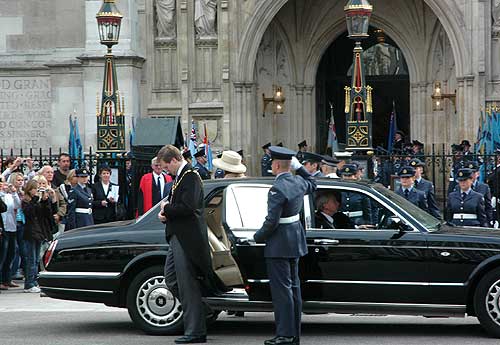
So, we watched the arrival of retired RAF officers and other dignitaries (including royalty) and walked on to Lambeth Palace, which was closed.
We walked on to the Imperial War Museum and, after walking across the main floor, looking only too briefly at the tanks and guns and other reminders of the wars, we decided that we needed to focus on just one exhibit. We chose the one on Secret War ; drawing on recently released files from MI5, MI6 and other Intelligence and Secret Service agencies, it provided a glimpse into the clandestine world of espionage, covert operations, and the work of Britain's Special Forces, highlighting especially their crucial role in winning WWII. At the beginning of the exhibit was a James Bond display and a message that the work (and lives) of these agents was not to be confused with what the Hollywood movies portray. The exhibit featured, as well as historical summaries, cases of “James Bond” like tiny cameras, pens, pipes, and decoding machines, and computers that gave accesse to images of the actual, recently declassified files about the agents. It was an altogether fabulous display opening up a world of undercover activity that extended way back to the 19 th century and extending into the current 21 st century.(14)
We stopped for lunch at a pub but the service was slow so we resigned ourselves to missing evensong at Westminster Abbey and visited instead the National Museum where we had time only for a walk through the Titian exhibit which featured, of course, “The Kiss.” Then we went across the street to attend Evensong at St. Martins in the Field; it was a dull service lacking in the grandeur and elegance (and musical excellence) which takes us back, on every trip to London, to Westminster Abbey.
So, we rushed back to the Abbey for an evening service that was to highlight again the RAF and the Battle of Britain. This was to be a smaller service but it was to be open to the public. The setting is, of course, spectacular and it seemed an entirely fitting place to sing, as a featured hymn, the official RAF Hymn (composed by John Bacchus Dykes 1823-76):
Lord of the universe and space, Lord of the heavens, by whose might |
Through sunlit days and darkest night, We thank you, Father, for the days |
We headed back to our B&B in silence and enjoyed a late supper at ‘our pub.’
Monday we took the Gatwick Express to the airport and boarded the return flight on Air Transat.(15)
-----------
FOOTNOTES:
1 - Skypark Airport Parking, 1-800-969-8032, 23 Fasken Dr. Toronto
2 - Depart: flight from Toronto to London Gatwick Sun 13 Sep 2009 at 17:50 arrive Gatwick Mon 14 Sep 2009 05:45 Flight TCX 166L Non-Stop Airbus A330
Flight GR 601 from London Gatwick (LGW) to Guernsey (GCI) on14/09/09 at 08:30 arrive 09:40
3 - St. George's Hotel, 21 St. George's Esplanade, St Peter Port, Guernsey. GY1 2BG Telephone (0)1481 721027 Fax (0)1481 729259
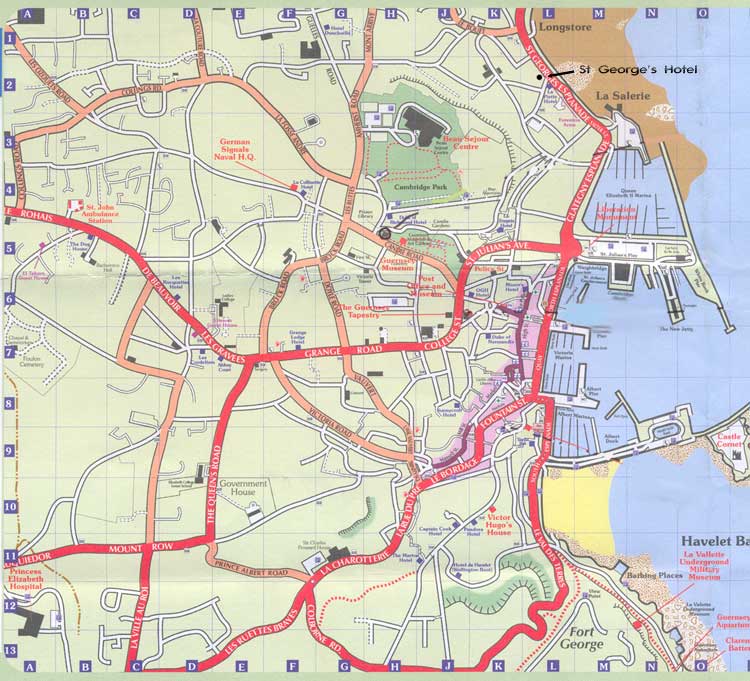
4 - Priaulx Library http://www.priaulxlibrary.co.uk/
5 - Hugo's house http://www.victorhugo.gg/hauteville-house/
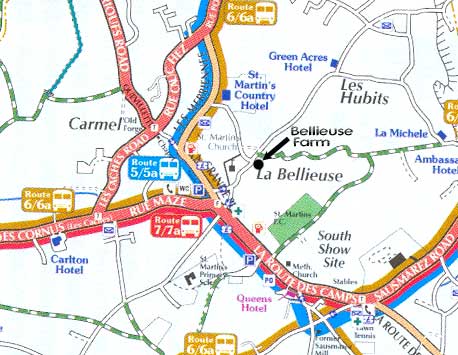
7 - The Gillette Family - http://www.gillettfamily.org/i476.htm
8 - Wonderful pictures of earlier photos of Tony and Judy
|
|
9 - La Nautique Restaurant http://www.lenautiquerestaurant.co.uk/
10 - List of good restaurants: Mora – 01481 715053 / Da Nello – 01481 721552 / Pier 17 – 01481 720823 /
La Nautique – 01481 721714
11 - Flight GR 604 from Guernsey (GCI) to London Gatwick (LGW) on 18/09/09 10:20 arrive 11:25
12 - Cherry Court Hotel Non-Smoking Hotel. 23 Hugh Street, London-Victoria. Westminster SW1V 1QJ.United Kingdom. Telephone No 020 7828 2840 Facsimile No 020 7828 0393
13 - Theme song at: http://www.youtube.com/watch?v=MRUeEJQSKbs
14 - Imperial War Museum http://london.iwm.org.uk/server/show/ConWebDoc.1448
15 - Return flight from London Gatwick to Toronto Mon 21 Sep 2009 11:45 Mon 21 Sep 2009 15:05 TS 723 Non-Stop Airbus A310 07H,07J

